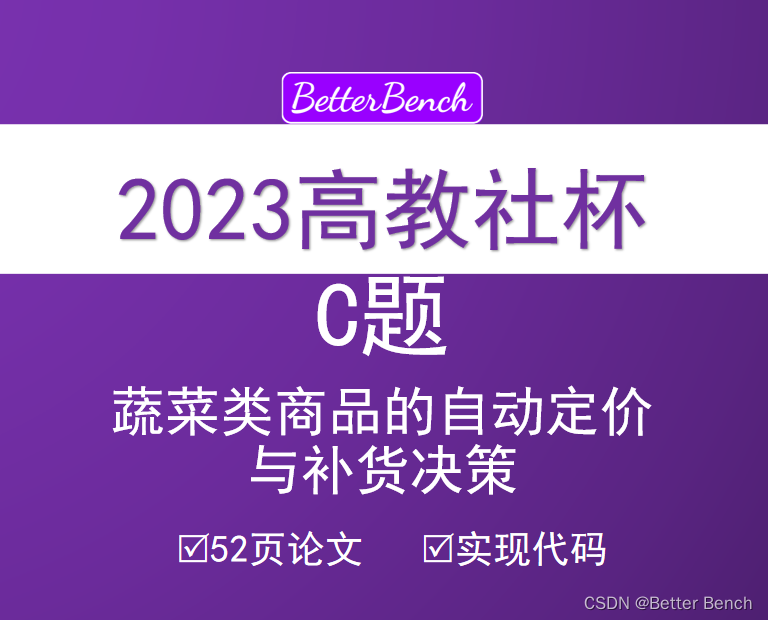[2023 Higher Education Society Cup] Question C: Automatic pricing and replenishment decision-making for vegetable commodities 52 pages of paper and code

1 question
Question C: Automatic pricing and replenishment decisions for vegetable commodities
In fresh food supermarkets, the shelf life of general vegetable products is relatively short, and the quality deteriorates with the increase of sales time. If most varieties are not sold on the same day, they cannot be resold the next day. Therefore, supermarkets usually restock every day based on the historical sales and demand of each product.
Since there are many varieties of vegetables sold in supermarkets with different origins, and the purchase and transaction time of vegetables is usually between 3:00 and 4:00 in the morning, merchants must do this without knowing exactly the specific items and purchase prices. Make replenishment decisions for each vegetable category on the day. The pricing of vegetables generally adopts the "cost-plus pricing" method. Shopping malls and supermarkets usually offer discounts for products that have been damaged during transportation or have deteriorated in quality. Reliable market demand analysis is particularly important for replenishment decisions and pricing decisions. From the demand side, there is often a certain correlation between the sales volume of vegetable commodities and time; from the supply side, the supply variety of vegetables is relatively abundant from April to October, and the restrictions on the sales space of supermarkets make reasonable sales Combination becomes extremely important.
Attachment 1 gives the product information of six vegetable categories distributed by a certain supermarket; Attachments 2 and 3 respectively give the sales details and sales of each commodity in the supermarket from July 1, 2020 to June 30, 2023. Relevant data on wholesale prices; Appendix 4 provides recent loss rate data for each commodity. Please establish a mathematical model based on the attachment and actual situation to solve the following problems:
Question 1 There may be certain correlations between different categories or items of vegetable products. Please analyze the categories and items of vegetables. Distribution patterns and interrelationships of product sales.
Question 2 Considering that supermarkets make replenishment plans by category, please analyze the total sales volume and cost markup of each vegetable category. The relationship between pricing, and the total daily replenishment volume and pricing strategy of each vegetable category in the next week (July 1-7, 2023) are given, so that supermarkets can maximize their profits.
Question 3 Due to the limited sales space of vegetable products, the supermarket hopes to further develop a replenishment plan for single products and requires available orders. The total number of products is controlled at 27-33, and the order quantity of each single product meets the minimum display quantity requirement of 2.5 kg. Based on the varieties available for sale from June 24 to 30, 2023, the single product replenishment volume and pricing strategy for July 1 are given, so as to maximize the profits of supermarkets and supermarkets while trying to meet the market demand for various types of vegetable commodities.
Question 4 In order to better make replenishment and pricing decisions for vegetable commodities, what other relevant data do supermarkets need to collect? Please give your opinions and reasons to help solve the above problems.
Attachment 1: Product information of 6 vegetable categories
Attachment 2: Sales flow details
Attachment 3: Wholesale prices of vegetable commodities< /span> (2) The loss rate in Appendix 4 reflects the recent loss of goods and is calculated from the data of the recent inventory cycle. (1) In Attachment 1, some item names include Numerical numbers indicate different sources of supply. Note
Attachment 4: Recent loss rate of vegetable commodities
2 Introduction to the paper
Vegetable replenishment and pricing strategy based on dynamic programming
Summary
Fresh food supermarkets are an industry facing complex operating environments and challenges. This article solves vegetable replenishment and pricing strategies for supermarkets based on a dynamic programming model.
Regarding question 1, in order to study the relationship between vegetable categories and single product sales, we first processed the data, matched the single product codes in Appendix 2 to the single product names in Appendix 1, and calculated the total daily sales volume of each category within three years. , after testing the difference in sales volume of each category and single product, Spearman correlation analysis was conducted on the significant data, and it was found that the sales volume of mosaic and leaves, peppers, and cauliflower were highly correlated among categories, and that of eggplant There is little correlation between the sales volume of edible fungi, peppers, and aquatic roots. Finally, 4 items with low correlation in each category were selected as the representative data of this category. It was found that the sales volume of purple eggplant, round eggplant, green eggplant, etc. were highly correlated among the single items, and the sales volume of fungus, fresh fungus, etc. were highly correlated. Sex is small. In order to study the distribution patterns of vegetable categories and single product sales, first sort the data in Appendix 2 according to the sales volume of each type of vegetable single product within three years, consider seasonality and other factors, and then divide it into four groups to calculate the sales volume of each single product. In terms of the total sales volume of this category, the sales of cauliflower and edible fungi accounted for at most 26% in the supermarket within three years, and the sales of nightshades accounted for at least 4%. Calculating the proportion of single products that accounted for more than 10% of the total sales in this category within three years, it was found that broccoli accounted for 68% of the cauliflower category and the highest sales volume, and peppers accounted for 5% of the pepper category. % sales volume is low etc.
Regarding question 2, in order to analyze the relationship between various vegetable categories and cost-plus pricing, cost-plus pricing is the sales price of the product based on cost plus profit. Drawing a scatter plot of the total daily sales volume of vegetable categories, cost price, and profit margin, it can be seen that they have a certain linear relationship. Therefore, a multiple regression analysis model is used to analyze their relationship. Finally, the F test is used to evaluate whether the entire regression model is effective and significant. On. In order to obtain the most profitable vegetable category replenishment volume and pricing strategy for the next week, we used random forest to predict the total daily replenishment volume of this week using historical data as the maximum sales volume of the vegetable category on that day, and then established a dynamic programming model to make decisions The variables are sales volume and sales unit price. The maximum sales volume is the predicted sales volume. The loss rate and wholesale price are the daily average values of each category of vegetables within three years. Finally, the legacy algorithm is used to calculate the sales unit price, sales quantity, and supermarket income of each type of vegetables in the next week, and the optimal combination of daily replenishment volume and pricing strategy are obtained, thereby obtaining a pricing strategy that maximizes the benefits of the six types of vegetables. .
For question three, we first processed the data and counted the sales of each single product from June 24 to 30, classified the 23 types of single products, considered factors such as seasonality, and obtained the sales volume of each single product based on the multiple regression equation calculated in question two. relationship with costs and profit margins. Based on this week's single product sales history data, a gray prediction model is used to predict the market demand for vegetable single products after performing a level comparison test. Finally, a dynamic programming model is established. The constraints are that the order quantity of a single product is greater than or equal to 2.5, the replenishment quantity of a single product is greater than or equal to the market demand, and the sales price is greater than the wholesale price. The particle swarm algorithm is used to iterate to obtain the vegetable replenishment quantity and pricing strategy.
Regarding question four, based on the solutions to the above three problems, two types of relevant data are obtained that can better make replenishment and pricing decisions for vegetable commodities. One type is related to its own operations, including inventory management data, seasonality Data etc. One category is related to marketing, including competitor data, market research data, etc.
Keywords: Spearman Correlation analysis; multiple regression analysis; random forest; dynamic programming; gray prediction

3 How to get it
Add me to buckle or
